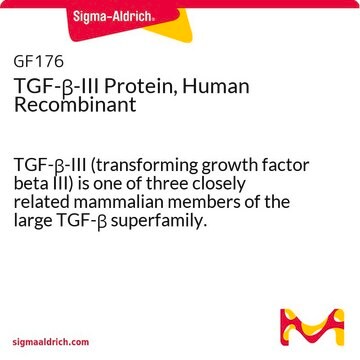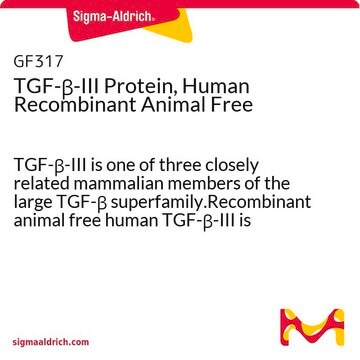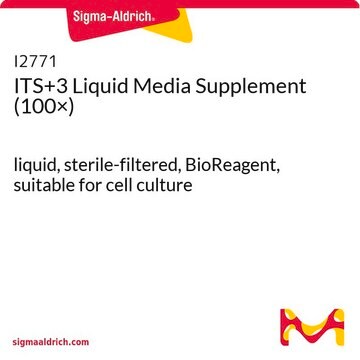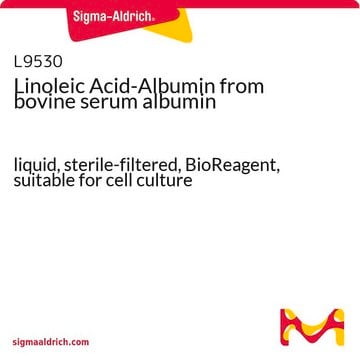T5425
Transforming Growth Factor-β3 human
≥97% (SDS-PAGE), recombinant, expressed in baculovirus infected Sf21 cells, powder, suitable for cell culture
Synonym(s):
hTGF-β3, TGF-β3
Sign Into View Organizational & Contract Pricing
Select a Size
All Photos(1)
Select a Size
Change View
About This Item
Recommended Products
Product Name
Transforming Growth Factor-β3 human, TGF-β3, recombinant, expressed in baculovirus infected Sf21 cells, powder, suitable for cell culture
biological source
human
Quality Level
recombinant
expressed in baculovirus infected Sf21 cells
Assay
≥97% (SDS-PAGE)
form
powder
potency
0.01-0.09 ng/mL ED50/EC50
quality
endotoxin tested
mol wt
predicted mol wt ~25 kDa
packaging
pkg of 2 μg
Looking for similar products? Visit Product Comparison Guide
General description
The TGFβ3 (transforming Growth Factor-β3) gene is mapped to human chromosome 14q24.3.
Application
Transforming Growth Factor-β3 human has been used to study the role of TGF-β3 in healing tendon-to-bone insertion and in chondrogenic differentiation.
Biochem/physiol Actions
TGF-β (transforming growth factor-β3) isoforms are significantly involved in inducing inflammatory responses. It is associated with vascular diseases, wound healing and ameliorating effect in venous leg ulcer. TGF-β3 has an antagonistic effect on TGF-β1 and reduces the degree of collagen type I deposition and fibroblast differentiation. As a result TGF-β3 might lead to ulcer chronicity due to hindered myofibroblasts formation. TGF-β is a key player in tumor formation and progression. Increased TGF-β3 expression is observed in cancer and adipose tissue fibrosis. TGF-β3 is crucial in tissue regeneration and scarless tissue repair.
TGF-β3 is less prevalent in natural expression than either TGF-β1 or TGF-β2, but it is the most abundant mRNA expressed in chick embryos. It is also expressed in human umbilical cord, in a variety of mesenchymal cells of human and rodent origin, and in several human carcinoma cells.
Physical form
Lyophilized from a 0.2 μm filtered solution in 35% acetonitrile and 0.1% trifluoroacetic acid containing 50 μg bovine serum albumin per 1 μg of cytokine.
Analysis Note
The biological activity is measured by its ability to inhibit the IL-4-dependent proliferation of mouse HT-2 cells.
Storage Class Code
11 - Combustible Solids
WGK
WGK 3
Flash Point(F)
Not applicable
Flash Point(C)
Not applicable
Personal Protective Equipment
dust mask type N95 (US), Eyeshields, Gloves
Choose from one of the most recent versions:
Already Own This Product?
Find documentation for the products that you have recently purchased in the Document Library.
Customers Also Viewed
Differential expression of TGF isoforms in breast cancer highlights different roles during breast cancer progression.
Hachim MY, et al.
Tumour Biology : the Journal of the International Society For Oncodevelopmental Biology and Medicine, 40(1) (2018)
Adipose tissue fibrosis in human cancer cachexia: the role of TGFβ pathway
Alves MJ, et al.
BMC Cancer, 17: 190 (2017)
The role of transforming growth factor β isoforms in tendon-to-bone healing.
Kim HM, et al.
Connective tissue research, ;52(2), 87-98 (2011)
Chondrogenic Differentiation of Menstrual Blood-Derived Stem Cells on Nanofibrous Scaffolds
Kazemnejad S, et al.
Methods in Molecular Biology, 149-169 (2013)
Roberts, A., and Sporn, M. et al.
Peptide Growth Factors and their Receptors I, 419-472 (1991)
Our team of scientists has experience in all areas of research including Life Science, Material Science, Chemical Synthesis, Chromatography, Analytical and many others.
Contact Technical Service









